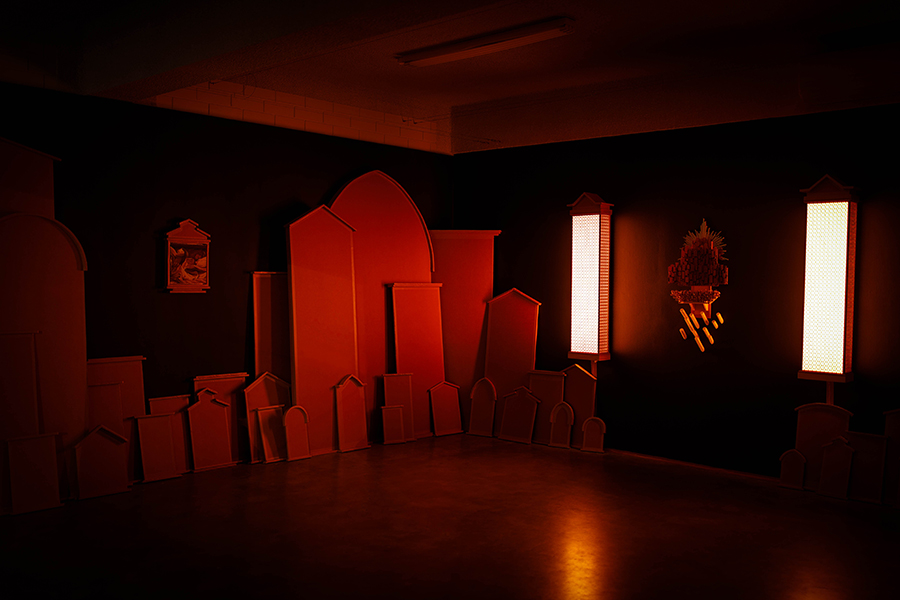Tower lays bare the mutability of the world before us, that all significant cultural aspects and scientific discoveries alike are mined from the same foundational core reality.
Image: Ash Tower, The Burning of Vision, 2021, Installation view. Photography by Rosina Possingham.
ASH TOWER (SA)
Tower’s work investigates how knowledge is created, distributed and documented. His work draws speculative threads between seemingly unrelated topics, for example, nuclear weapons, reliquaries, and ancient Roman rituals. Sculptures, drawings and multi-object installations take the form of epistemological headstones, commemorating traces of human enterprise, as well as imagining the ruins of the future.
In his show Countless Afterlives (2022), a reliquary sits atop a dolly, flanked by a squad of padded yellow vinyl obelisks, whose forms echo the gothic windows or arches of a cathedral. The work is charged with a funerary solemnity. The reliquary is closed, and therefore the object it is enshrining is withheld – lingering as a question put to its viewer. Tower tells me he envisions it holding the remains of a “radioactive saint.” Adorning the sides of the structure are small sheets of lead, into which constellation-like forms have been inscribed. These sheets reference the ancient Roman Defixiones, tablets used to pray for justice, or the manifestation of a curse: the line between the two is fine. The markings are derived from drones, replicating the cross-hairs and co-ordinates as they appear on the user interface during a strike.
Glass, lead, and radiation are listed as materials that link both funerary architecture and atomic technology. Lead, for example, is used both as a means of protection against the harms of radiation and to line the coffins of members of the British royal family, a tradition that is still observed today. Contrasting their use in these disparate contexts, Tower lays bare the mutability of the world before us, that all significant cultural aspects and scientific discoveries alike are mined from the same foundational core reality. In doing so, Tower emphasises that mechanisms of knowledge and culture are constructed. He describes his fascination with science being “a set of crude tools,” which are then implemented to draw a wide range of conclusions. One previous project, Studies of Nature (2017), touched on this explicitly in its use of previously published (and then withdrawn) scientific papers as its content.
In his 2018 work Lab Hands, Tower framed silicone calcium lab mats, which were decorated with chemical spillage and staining. Tower classifies the work as documenting “moments in which the hand fails to execute the action the mind conceives.” The gap between intention and action is made visible. Tower explains “When something breaks, it reveals its architecture.” Tower implements wonder as a guiding force and uses it to reorganise and conduct information into new configurations. History, technology, and architecture are all means of navigation. But categorisation generates a desire for its opposite, an unravelling. Tower’s practice may be viewed in relation to this desire to dissolve. Failure becomes a key ingredient, and diversion an intention. Both are explored for their potential to be a destination in and of themselves and not just as the departure from an objective.
Tower’s Samstag Scholarship will see him pursue studies in Europe, continuing his research of the influence of European art and architecture, in particular the Western European Renaissance and how it continues to inform aesthetics and histories up into the present day.
Essay by Gemma Topliss, September 2023.
Gemma Topliss is a writer and artist from Naarm/Melbourne.
Meet the artists—interviews with Ash Tower discussing his scholar experience at the BSR: 2024 and 2025

